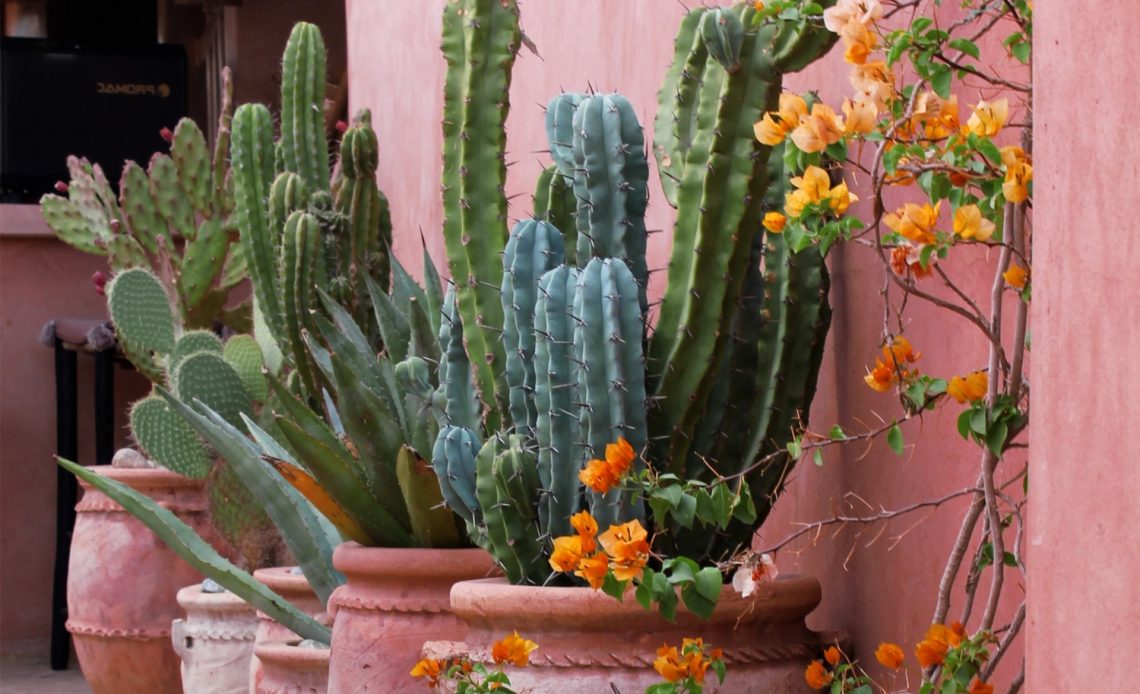

We’re here to help! Wild Yards is a completely free website that is 100% dedicated to helping you create a wildlife-friendly, sustainable yard. Read more
WildYards is reader-supported. When you buy a product through a link on our site, we may earn a comission. Every product is independently selected by our (obsessive) editors and our reviews are unbiased and objective. Read more about our mission or our privacy policy.
If you live in the American Southwest, consider yourself lucky!
Your ecoregion is uniquely suited to creating an authentic desert landscape, filled with cactus and succulents arrangements that gardeners in other parts of the United States may struggle to grow.
Cactus is just the plant you need to turn your backyard into a desert oasis. Unfortunately, pretty as these plants may be, they also tend to grow slowly.
If you want to dress up your desert landscape in a jiffy, then choose only the fastest-growing cactus species for your garden.
Argentine saguaro, Eve’s needle, blue torch, and prickly pear are all fast-growing cacti that will quickly fill in the spaces of your landscape. Walking stick, Peruvian apple, and Mexican fence post are also good choices.
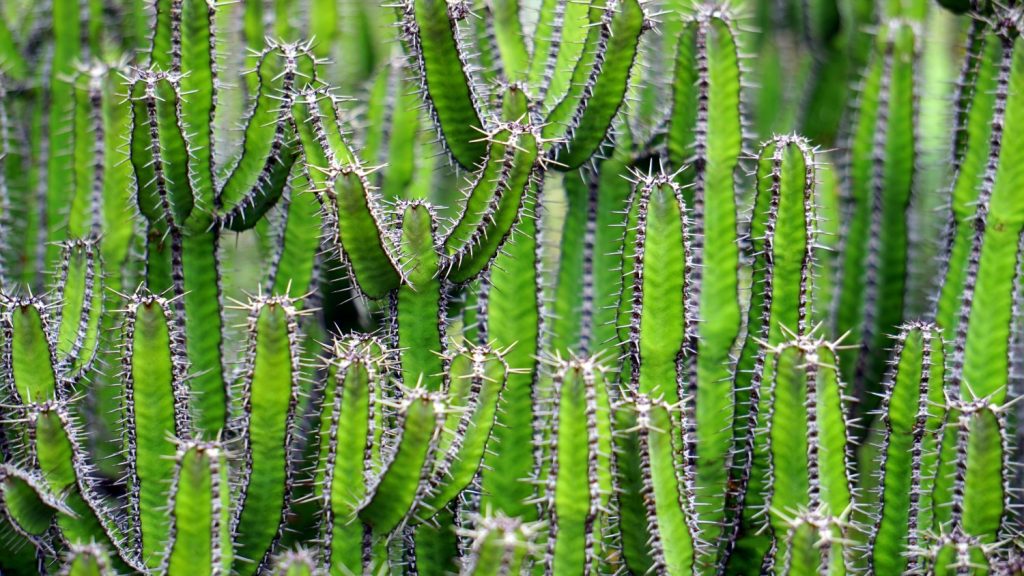
15 Fast-growing cacti for desert gardens
Your sand beds have been poured and raked and are prepped for planting. You’re finally ready to turn your backyard into the Southwest-inspired landscape of your dreams.
You know it can take a while for any plant to get established, and cactus tends to have a slower growth rate than others. But with the right cultivars, you can achieve that authentic desert look much more quickly.
Get the most out of your garden as fast as possible by planting these 15 fast-growing cactus species.
Argentine Saguaro
| Scientific name | Echinopsis terscheckii |
| Growing zones | 8 through 11 |
| Maximum size | 15’ to 30’ tall by 6’ to 8’ wide |
| Sunlight requirements | Full sunlight |
| Soil preference | Well-draining sandy soil |
| Soil pH | 6.1 to 6.5 |
| Water needs | Low to moderate; drought-tolerant, but grows more quickly when watered regularly |
| Blooming period | Mid-spring through early fall |
No plant says “desert” quite like a saguaro cactus. Unfortunately, saguaros grow incredibly slowly. Plants typically measure a measly 1 to 1 ½ inches tall at 8 years of age! And it can take 75 years before they begin producing lateral stems, or arms.
If you want to dress up your landscape with a real saguaro, but you don’t want to wait decades for them to reach maturity, consider the Argentine saguaro, instead.
The Argentine saguaro grows very quickly, at a rate of 18 inches per year. Plants are bright green with a golden cast, giving the cacti a halo-like appearance when it’s backlit by the sun.
Branches produce 8 to 14 ribs, and plants bloom from spring to fall, producing gorgeous white flowers that attract beneficial pollinators, especially butterflies.
Argentine saguaro cacti are drought-tolerant and can grow in nutrient-poor soils. That said, plants will grow much more quickly when watered and fertilized regularly.
Feed your Argentine saguaro throughout the growing season to maximize the plant’s growth. Use a low-nitrogen fertilizer, like bone meal, every 3 to 6 weeks during the growing season. And amend your native soil with manure and compost to keep it nutrient-rich and loamy.
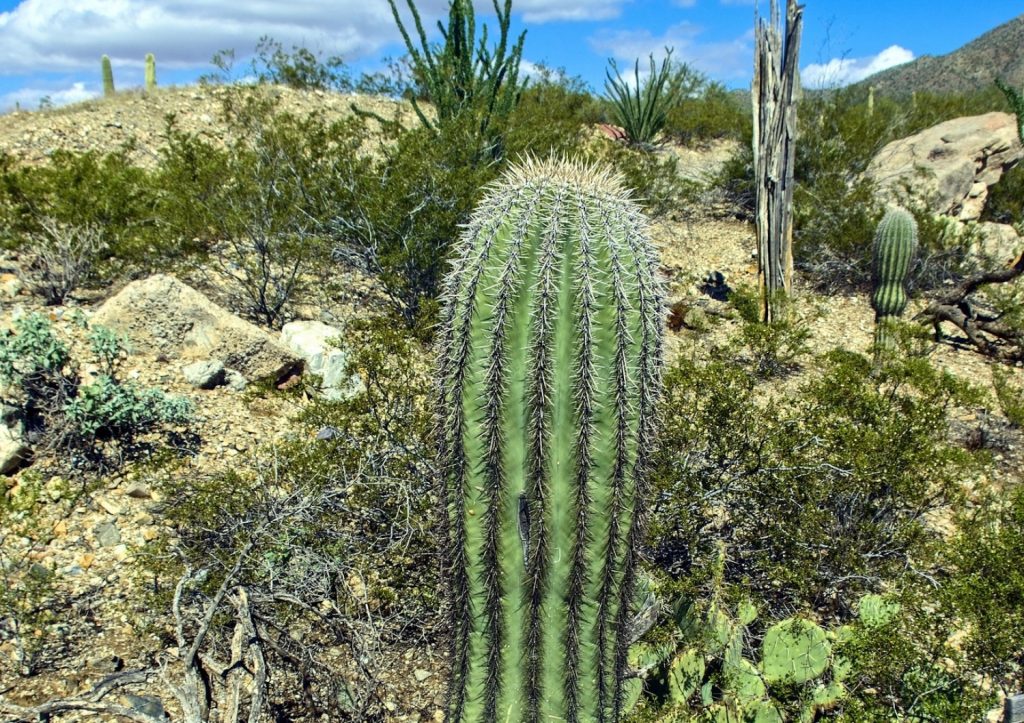
Dragon Fruit
| Scientific name | Selenicereus undatus |
| Growing zones | 9 through 11 |
| Maximum size | 5’ to 10’ tall by 10’ wide |
| Sunlight requirements | Full sunlight |
| Soil preference | Loose, loamy, and rich in organic materials, like compost |
| Soil pH | 6.0 to 7.0 |
| Water needs | Moderate; weekly waterings usually suffice. |
| Blooming period | Early summer to late fall |
Often grown specifically for its red spiny, sweet-tasting fruits, dragon fruit also serves as an ornamental cactus thanks to its interesting appearance.
The dragon fruit is an exotic-looking tropical plant with a trunk that resembles that of a palm tree, and a cascade of cactus-like vining branches hanging down all around it.
Dragon fruit cacti are fast-growing. Cuttings can grow up to an inch per day, and plants often produce fruits within 2 to 3 years. Plants grow fastest in nutrient-rich soils that retain a bit of moisture but drain well.
In the summer months, dragon fruits produce eye-catching white bell-shaped flowers that only bloom in the cool of night, and must be pollinated quickly to produce fruits.
Of course, you don’t have to grow the dragon fruit cactus for its fruits alone. This fast-growing cactus fits right in with any desert-inspired backyard and is so fast-growing, it more than earns its spot in your landscaping.
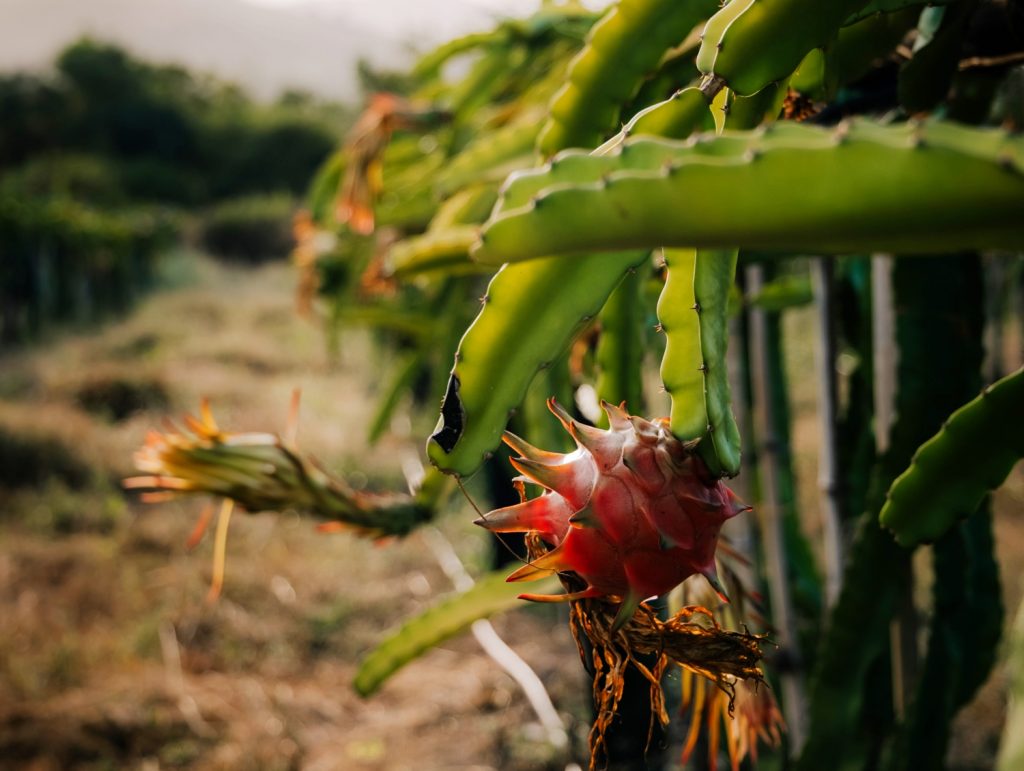
Walking Stick
| Scientific name | Cylindropuntia imbricata |
| Growing zones | 5 through 11 |
| Maximum size | 3’ to 5’ tall by 3’ to 5’ wide |
| Sunlight requirements | Full sunlight |
| Soil preference | Sandy, dry, well-draining soil |
| Soil pH | 6.0 to 7.5 |
| Water needs | Low; extremely drought-tolerant |
| Blooming period | Spring to midsummer |
Native to the Southwestern United States and parts of Mexico, walking stick cactus is also known as cholla or cane cactus, and plants are very fast growing. In ideal conditions, this cactus can grow up to 15 inches per year.
Walking stick produces cylindrical stems that branch off laterally, producing a “bushy” cactus that will act as a shrub of sorts for your desert-inspired cactus beds.
One thing to note about this plant is its water requirements. Walking stick cactus is incredibly drought-tolerant. Plants will continue growing well, in spite of dry conditions.
Once established, these plants can fill in very quickly.
During the walking stick cactus’s blooming period, plants produce vibrant flowers, which range in color from white to yellow to pink, red, and purple. The flowers easily attract the attention of pollinators, particularly hummingbirds.
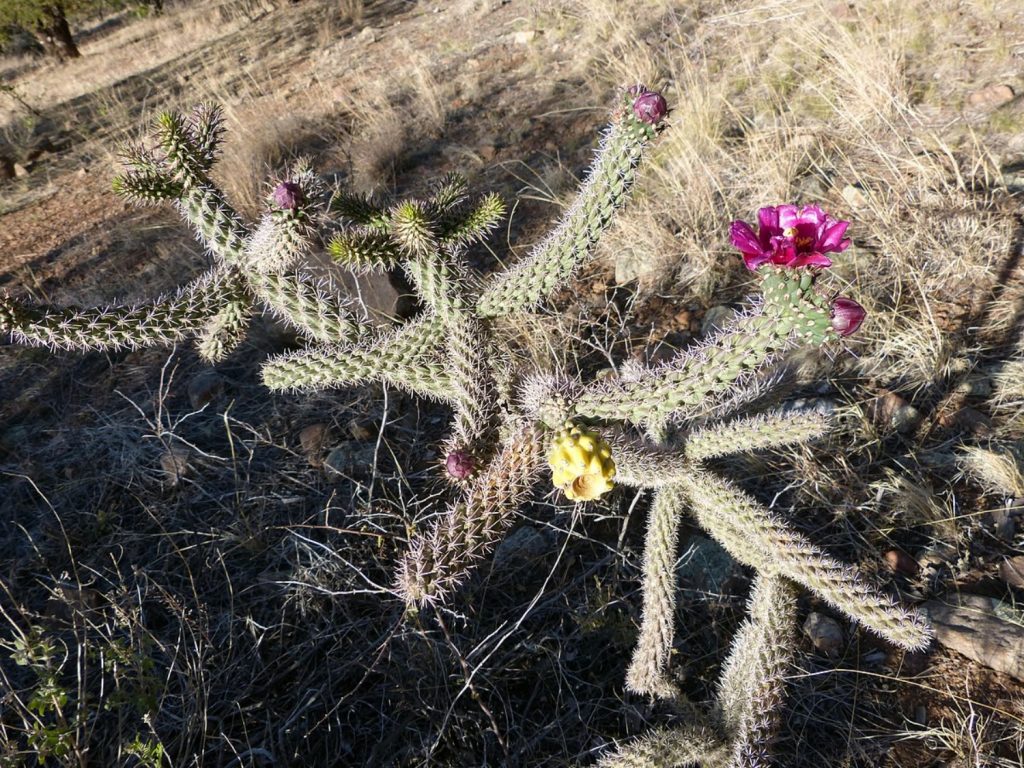
Eve’s Needle
| Scientific name | Austrocylindropuntia subulata |
| Growing zones | 9 through 11 |
| Maximum size | 9’ to 13’ feet tall by 9’ to 13’ wide |
| Sunlight requirements | Sull to partial sunlight |
| Soil preference | Sandy to loamy, as long as it is well-draining |
| Soil pH | 6.1 to 7.8 |
| Water needs | Low to moderate |
| Blooming period | Mid-spring to midsummer |
A beautiful tree cactus native to the Peruvian Andes, Eve’s needle is an oblong cactus that is yellow-green. When grown in pots, these plants typically only measure 5 inches in length. But in the right landscape, they can grow up to 13 feet at maturity.
Eve’s needle grows quickly at a rate of about 3 feet per year. This is a robust cactus with a shrub-like growth habit that allows it to work well as an accent plant, especially for smaller spaces.
You expect cacti to have a few spines here and there, but Eve’s needle is absolutely covered in them. So be careful when working with this cactus!
Plants produce small cup-shaped flowers in shades of white, pink, yellow, and peachy orange. This cactus can easily be propagated by simply sticking clipped stems into well-draining soil and watering them regularly until established.
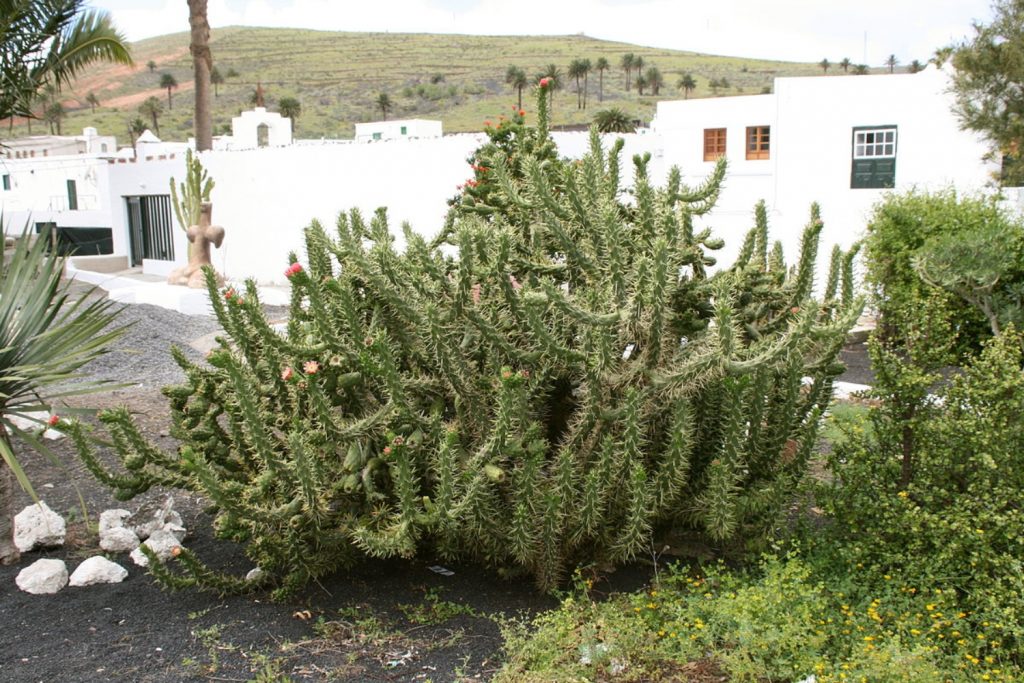
Peruvian Apple
| Scientific name | Cereus repandus |
| Growing zones | 9 through 11 |
| Maximum size | 8’ to 30’ tall by 2’ wide |
| Sunlight requirements | Full to partial sunlight |
| Soil preference | Sandy soil that drains well |
| Soil pH | 5.0 to 7.0 |
| Water needs | Low |
| Blooming period | Late spring to early fall |
The Peruvian apple cactus is an upright variety that produces oblong stems with distinctive spine-lined blades.
In the cooler months, Peruvian apple cacti produce brilliant white, yellow, and pink flowers, which bloom at night and are typically pollinated by bats.
You may already be familiar with the Peruvian apple cactus. But did you know that the apples themselves are edible?
The fruits of the Peruvian apple cactus, which are shaped like apples (no surprise there), are mild and sweet with notes of watermelon and kiwi. Sounds pretty good, huh?
It’s worth noting that these plants may become top-heavy. Consider using stakes to prevent this cactus from falling over.
This fast-growing variety of cactus can grow up to 2 feet per year in ideal conditions. Once established, these plants grow more up than out, and act as a “tree” for your desert-inspired landscape.
Easter Lily Cactus
| Scientific name | Echinopsis ancistrophora |
| Growing zones | 8 through 11 |
| Maximum size | 1’ to 2’ tall by 1’ to 2’ wide |
| Sunlight requirements | Full to partial sunlight |
| Soil preference | Sandy to sandy loam; must drain well |
| Soil pH | 6.0 to 7.0 |
| Water needs | Low; drought-tolerant |
| Blooming period | Spring to summer |
The Easter lily cactus is adorable. There’s just no other way to say it. This barrel-shaped cactus looks like a cute pincushion, and when it blooms at the start of the growing season, it produces long, tubular blooms in shades of white to pink.
The Easter lily cactus plant’s starburst-shaped flowers will attract the attention of everyone who visits your garden, whether it’s your neighbor or your local bee population.
These plants typically grow very quickly, especially when all of their growing requirements are met. You can expect your Easter lily cactus to grow up to 2 inches per year.
Now, on the surface, that doesn’t sound like much. But when you consider that the maximum size of the Easter lily cactus is only 24 inches tall by as many inches wide, that’s quite a bit of growth for a single season.
It’s critical that you avoid overwatering your Easter lily cactus. This plant is not tolerant of excess water. Boggy soil will stunt this cacti’s growth or kill it entirely.
Blue Torch
| Scientific name | Pilosocereus azureus |
| Growing zones | 9 through 11 |
| Maximum size | 10’ to 20’ tall by 2’ wide |
| Sunlight requirements | Full to partial sunlight |
| Soil preference | Loose, loamy, well-draining soil that is moderately rich in organic materials |
| Soil pH | 6.0 to 7.0 |
| Water needs | Low; drought-tolerant |
| Blooming period | Spring to summer |
So named because these columnar cacti produce blue-green stems, the blue torch cactus is an elegant choice for desert-inspired landscapes, especially if you’re using subdued colors, or going for a “retro desert motel” vibe.
Blue torch cacti produce oblong stems that are sometimes segmented, adding interest to an already interesting plant.
In the spring and summer months, blue torch cacti bloom, producing white, yellow, orange, and pink flowers that look like a cross between a water lily and a daisy.
The flowers are typically pollinated by bees and wasps, but hummingbirds and butterflies won’t pass up a chance to visit them, either.
Regular watering and fertilization are needed to speed up the blue torch cacti’s growth rate.
Feed your blue torch a slow-release fertilizer designed for cacti and succulents once during the growing season, and water the plants regularly. This will enable them to achieve their maximum growth rate of 12 inches per year
Rat Tail
| Scientific name | Disocactus flagelliformis |
| Growing zones | 10 through 11 |
| Maximum size | 4” tall by 3’ to 6’ wide |
| Sunlight requirements | Full sun |
| Soil preference | Loamy well-draining soil that is moderately fertile |
| Soil pH | 5.0 to 6.0 |
| Water needs | Moderate |
| Blooming period | Spring to summer |
Don’t let its name fool you. The rat tail cactus is a beautiful cultivar, featuring long trailing stems covered in fine spines.
Fast-growing at a rate of about a foot a year, the rat tail cactus works well as a trailing ground cover, or for filling hanging baskets and southwest-style planters.
The rat tail cactus produces trumpet-shaped flowers with open faces that come in shades of orange, pink, and red.
This vibrant cactus is perfect for adding a splash of color to otherwise monochromatic desert landscapes.
To maximize your rat tail cacti’s growth rate, be sure to fertilize it regularly. Use a balanced water-based NPK fertilizer, like 2-7-7. The relatively low levels of nitrogen and high levels of phosphorus and potassium will encourage the plant to bloom more.
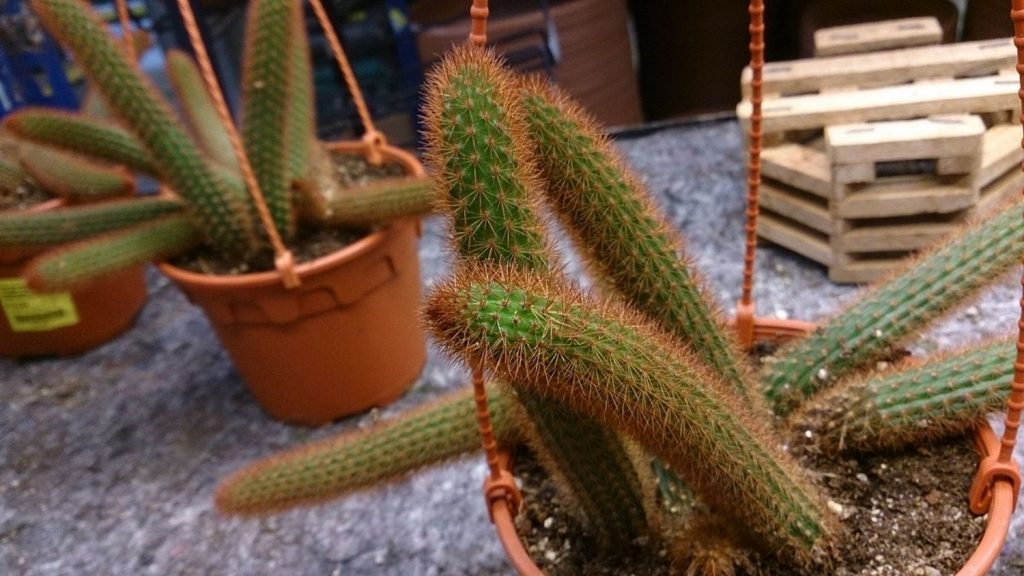
Queen Of The Night
| Scientific name | Epiphyllum oxypetalum |
| Growing zones | 10 through 11 |
| Maximum size | 8’ to 10’ tall by 2’ to 3’ wide |
| Sunlight requirements | Bright indirect light |
| Soil preference | Sandy to loamy well-draining soil |
| Soil pH | 5.5 to 6.5 |
| Water needs | Low to moderate |
| Blooming period | Midsummer |
From the tropical rainforests of Mexico and South and Central America, the queen of the night cactus is so named because its intricate white blooms open only one night out of the entire year.
After the delicate blossoms are pollinated by insects and bats, they wilt soon after and are dead by morning.
The blooms are soon replaced by purple-red oblong fruits, which are edible, and taste a lot like dragon fruits.
Also known as Dutchman’s pipe, the queen of the night cactus is considered an orchid cactus, a class of cacti that are prized for their showy flowers.
Queen of the night is an easygoing plant that doesn’t require much care. Simply plant this cactus in sandy, well-draining soil, and water it once a week. Plants may grow slowly for the first few seasons. But once they get established, queen of the night cacti can grow a foot or more per year.
Prickly Pear
| Scientific name | Opuntia |
| Growing zones | 7 through 10 |
| Maximum size | 6’ to 8’ tall by 6’ to 8’ wide |
| Sunlight requirements | Full to partial sunlight |
| Soil preference | Sandy to loamy, as long as it drains well |
| Soil pH | 6.0 to 7.5 |
| Water needs | Low to moderate |
| Blooming period | Late spring to midsummer |
Prickly pear is one of the fastest-growing cacti around — which is a good thing because many desert animals favor its tasty fruits. Plants may take a few seasons to get established. But once they take hold, they can grow 3 to 6 inches a year.
Prickly pear is versatile. It’s more tolerant of cooler temperatures than many of the other cacti mentioned here. It’s also adaptable to a variety of soil types, as long as they drain well.
These cacti produce broad pads, which are actually modified stems. Each pad is coated in long spines and fuzzy glochids — fine barbed hairs that irritate the skin, and are not easy to remove.
As long as you’re careful to wear long sleeves and avoid touching this fast-growing species, prickly pear is so rewarding to grow. Not only do this cacti’s yellow, orange, and pink flowers attract pollinators, but the cactus itself is edible.
Prickly pear cactus pads have a mild yet tangy flavor and a delicious crunch, which makes them perfect for grilling and sauteeing.
The prickly pear’s fruits, which, funnily enough, are called tunas, are equally delicious and possess a sweet, tart flavor. The fruits are also loaded with antioxidants, which makes prickly pear a good choice for your desert landscape and your backyard garden.
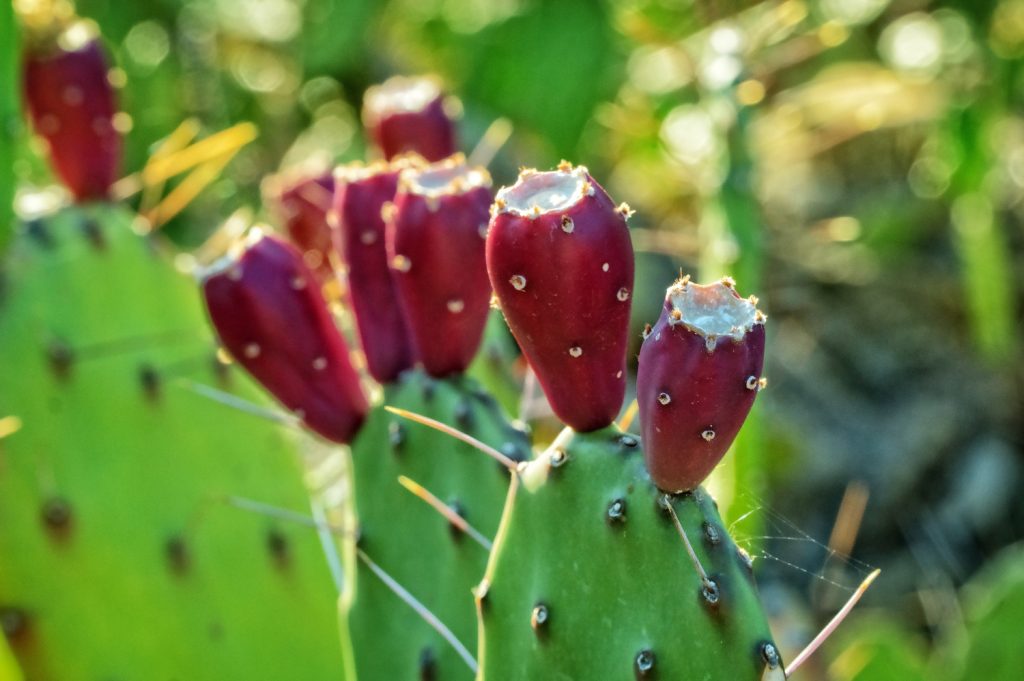
Sticks Of Fire
| Scientific name | Euphorbia tirucalli |
| Growing zones | 10 through 12 |
| Maximum size | 25’ tall by 8’ to 10’ wide |
| Sunlight requirements | Full sunlight |
| Soil preference | Sandy to loamy as long as it drains well |
| Soil pH | 6.0 to 7.0 |
| Water needs | Low to moderate |
| Blooming period | Fall to spring |
Sticks of fire cacti are exciting to look at. This cactus produces dense stick-like stems that are bright green near the base of the plant, turning orange and red near the ends — as if the plant’s foliage had been dipped in an open flame.
This cactus grows best in full sun. It is incredibly heat tolerant and can continue growing well as long as its water requirements are met.
As a cactus, sticks of fire is accustomed to drier soils. However, plants will grow much more quickly when kept on a strict watering schedule.
Try to keep your cacti’s soil ever so slightly moist to the touch. This will help them grow several inches per year. Young plants grow faster than mature plants. The sticks of fire cacti’s growth rate slows as the plant ages.
These plants can be grown as trees, but they can also be trained to produce a dense shrub-like shape. Top out your sticks of fire cactus to encourage the plant to produce more fiery red foliage.
Old Lady Cactus
| Scientific name | Mammillaria hahniana |
| Growing zones | 11 through 13 |
| Maximum size | 10” tall by 20” wide |
| Sunlight requirements | Full sunlight |
| Soil preference | Sandy, well-draining soil |
| Soil pH | 6.0 to 7.0 |
| Water needs | Low; drought-tolerant |
| Blooming period | Late spring to summer |
To be sure, old lady cactus doesn’t get very big. But it can grow quickly, at a rate of several inches per year. And even though it won’t work as a shrub or tree in your desert landscape, it is an effective ground cover.
The old lady cactus is so named because of the long gray hair-like spines it produces. Plants are covered in these fuzzy spines, which have two key benefits.
First, these spines protect the plants from coyotes, rabbits, and other animals that eat cacti.
Second, the spines protect the plant from the heat of the sun, allowing it to retain more water so it can grow quickly.
Old lady cactus blooms from spring to summer, producing tiny reddish pink blossoms at the top of the plant, like a flower crown. Although the flowers are relatively short-lived, lasting only a few days, they’re an attractive source of nectar and pollen to passing insects.
Mexican Fence Post
| Scientific name | Pachycereus marginatus |
| Growing zones | 9 through 11 |
| Maximum size | 12’ to 25’ tall by 6’ to 10’ wide |
| Sunlight requirements | Full to partial sunlight |
| Soil preference | Loose, loamy, well-draining soil that is moderately fertile |
| Soil pH | 9 through 11 |
| Water needs | Low; drought-tolerant |
| Blooming period | Spring to summer |
If you’re looking for taller options for your cactus garden beds, the Mexican fence post deserves another look. Similar in appearance to the blue torch cactus, this particular species is different in that its foliage is not blue, but rather, bright lime green.
Mexican fence post cactus grows super fast, at a rate of 1 to 3 feet a year.
Plants are extremely drought-tolerant but should be watered regularly and kept in loose, moderately fertile soil to maximize their growth potential.
Mexican fence post cactus is very linear, so it can be used to create a hedge of sorts, or as a backdrop for the more colorful cacti in your landscaping.
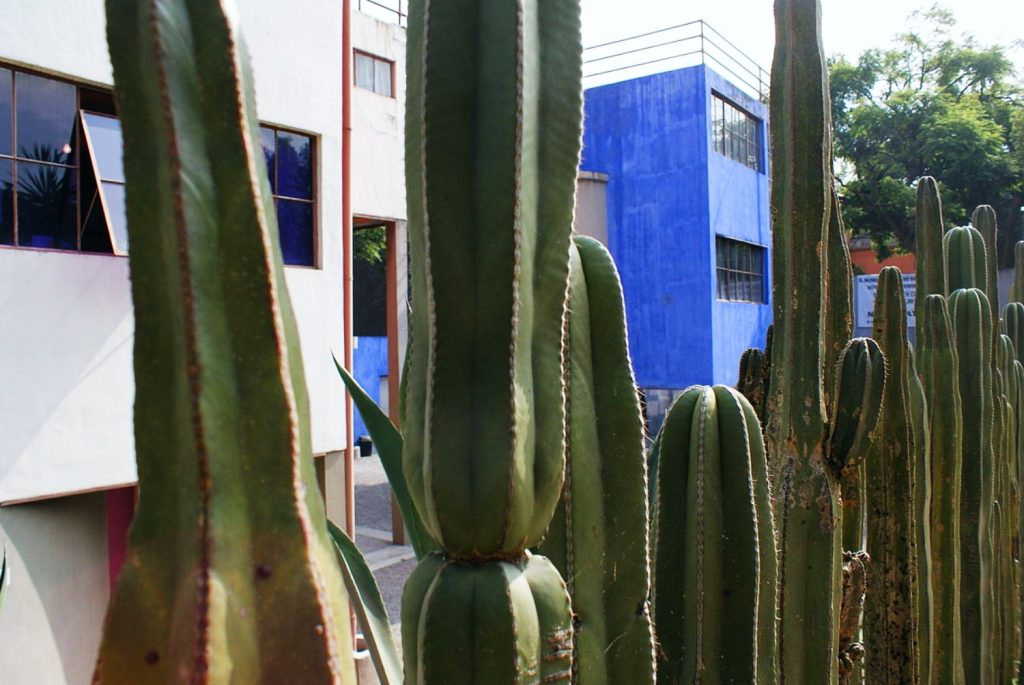
San Pedro
| Scientific name | Echinopsis pachanoi |
| Growing zones | 8 through 10 |
| Maximum size | 10’ to 20’ tall by 5’ to 6’ wide |
| Sunlight requirements | Full sun |
| Soil preference | Loamy soil that is fertile and well-draining |
| Soil pH | 6.0 to 7.0 |
| Water needs | Low |
| Blooming period | Summer |
A relative of the Argentine saguaro, the San Pedro cactus is similar in appearance, but a bit smaller in size than its cousin. Plants produce four ribs. Older growth is bright green, and new stems are a lovely shade of gray-green
The San Pedro cactus blooms once a year in summer, usually in June, producing trumpet-shaped white flowers. Like the queen of the night cactus, San Pedro cacti bloom after sundown.
Although the San Pedro cactus can grow up to two feet a year, it can take plants up to 12 years before they start blooming.
The San Pedro cactus is another fast-growing alternative to the traditional saguaro. These cacti can be used to draw the eye upward, encouraging your garden’s visitors to explore every inch of the landscape.
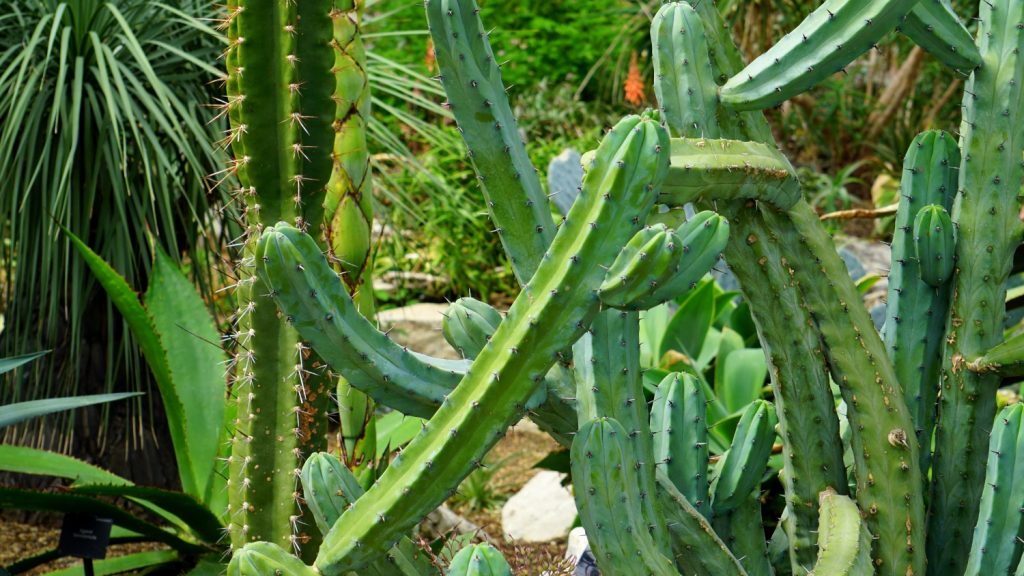
Fishbone
| Scientific name | Disocactus anguliger |
| Growing zones | 10 through 12 |
| Maximum size | 6” tall by 3’ wide |
| Sunlight requirements | Bright indirect light |
| Soil preference | Loose, well-draining soil that is moderately fertile |
| Soil pH | 5.0 to 6.0 |
| Water needs | Moderate |
| Blooming period | Late spring to early summer |
The fishbone cactus is native to Mexico and is often grown as a houseplant. Its vibrant green foliage has a glossy finish which makes it quite attractive, and its zig-zag-shaped leaves add interest to your southwest-inspired landscape.
These plants begin producing flowers after 3 years of age.
The fishbone cacti’s flowers are tubular and star-shaped and come in shades of white and pink. Some flowers are a combination of the two. The flowers typically only last for a few days, but they’re well worth the wait.
The fishbone cactus is a fun plant that will add a tropical element to your desert landscape. In ideal conditions, these plants can grow more than a foot a year. Their trailing nature makes them an awesome ground cover.
It’s also worth noting that fishbone cacti are perfect for hanging baskets growing in full sun and large urns situated in your cactus beds.

Tips for choosing fast-growing cactus for your landscape
Unlike traditional foundation landscape plants, like azaleas and hydrangeas, which require regular maintenance, cacti are extremely low-maintenance.
However, you can save yourself both time and money by choosing fast-growing cacti that share similar growing requirements.
Be sure to keep your landscape’s sun exposure and native soil in mind.
Loamy soils may require an extra dose of sand to improve drainage for drought-tolerant cactus cultivars, like Easter lily cactus and old lady cactus.
Conversely, your sandy soil will need to be mixed with compost, kelp meal, or sphagnum peat moss to make it more appropriate for nutrient-loving cacti, like dragon fruit.
Choosing cacti that are naturally suited to your backyard environment will also prevent them from getting sick and turning white.
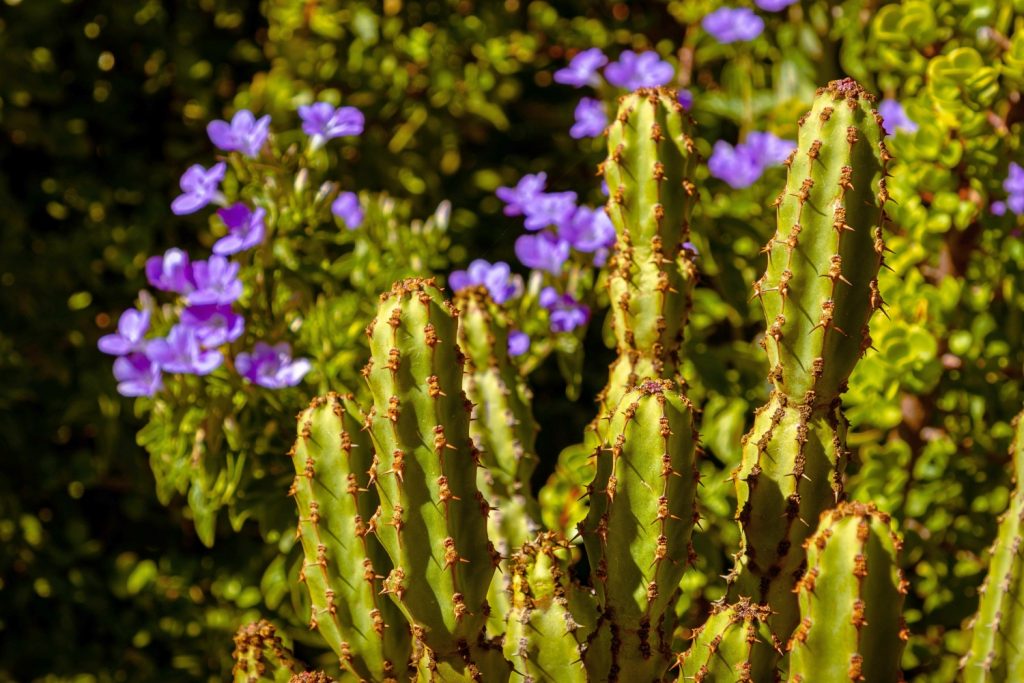
How to grow cactus successfully
Remember that a cacti’s growing requirements are subject to change.
For instance, the prickly pear cactus is said to love full sun and dry soils. But you may find that your prickly pear cactus wilts in the heat of the afternoon sun and needs its soil to stay moist.
Cactus growing in cool environments will require more sunlight and less water, whereas cacti growing in hot environments will require less sunlight and more water — often regardless of what their growing requirements state.
And this isn’t necessarily true for cactus alone. This goes for all sorts of plants!
So keep a close eye on your cacti during their first growing season so you can make adjustments as necessary.
This will allow your cactus plants to grow as fast as possible.
